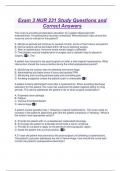Exam 3 NUR 231 Study Questions and
Correct Answers
The nurse is providing preoperative education for a patient diagnosed with
endometriosis. A hysterectomy has been scheduled. What education topic should the
nurse be sure to include for this patient?
A. Menstrual periods will continue for several months, some of them heavy and painful.
B. Normal activity will be permitted within 48 hours following surgery.
C. After a hysterectomy, hormone levels remain largely unaffected.
D. The bladder must be emptied prior to surgery and a catheter may be placed in
surgery. ✅d. Thd
A patient has returned to the post-surgical unit after a total vaginal hysterectomy. What
intervention should the nurse prioritize during the initial postoperative period?
A. Monitoring the incision sites for bleeding and hemorrhage.
B. Administering sitz baths every 4 hours and opioids PRN.
C. Monitoring and counting perineal pads and controlling pain.
D. Avoiding analgesics unless the patient's pain is unbearable ✅C
A patient is being discharged home after a hysterectomy. When providing discharge
education for this patient, the nurse has cautioned the patient against sitting for long
periods. This advice addresses the patient's risk of what surgical complication?
A. Pudendal nerve damage
B. Fatigue
C. Venous thromboembolism
D. Hemorrhage ✅C
A patient is post-operative day 1 following a vaginal hysterectomy. The nurse notes an
increase in the patient's abdominal girth and the patient complains of "bloating." What is
the nurse's most appropriate action?
A. Provide the patient with an unsweetened, carbonated beverage.
B. Encourage the patient to ambulate and provide a warm compress.
C. Provide an ice pack to apply to the perineum and suprapubic region.
D. Assist the patient into a prone position. ✅B
A 31-year-old patient has returned to the post-surgical unit following a hysterectomy.
The patient's care plan addresses the risk of hemorrhage. How should the nurse best
monitor the patient's postoperative blood loss?
,A. Have the patient void and have bowel movements using a commode.
B. Count and inspect each perineal pad that the patient uses. *
C. Swab the patient's perineum for the presence of blood at least once per shift.
D. Leave the patient's perineum open to air to facilitate inspection. ✅B
A nurse providing prenatal care to a pregnant woman is addressing measures to reduce
her postpartum risk of cystocele, rectocele, and uterine prolapse. What action should
the nurse recommend?
A. Maintenance of good perineal hygiene
B. Prevention of constipation
C. Increased fluid intake for 2 weeks postpartum
D. Performance of pelvic muscle exercises * ✅D
Insulin to carb ratio ✅1 unit insulin to 15 g arbs
Diabetic food classification system ✅a. 50-60% of calories should be from
carbohydrates
B. 20-30% from fats
C. Animal fats do not need to be removed from the diet.
D. 10-20% from protein
E. Low fat does not mean low sugar or low glycemic index.
Diabetics and alcohol ✅a. Talk to MD
B. Glucagon and hypoglycemia
C. Medical Bracelet
D. Alcoholic intake quantity
Educate friends
Diabetes and exercise ✅1. FIT acronym
A. Frequency
I. Regular 3-4 times per week
B. Intensity
I. 60-80% of maximal heart rate
C. Time
I. Aerobic activity
Ii. 20-30 mins with 5-10 min warm up
2. Relationship of exercise, insulin, & BS
A. Need both insulin and glucose for exercise
B. Exercise makes BS drop
3. Patient education (Chart 51-4)
Diabetic nursing managment ✅i. Survival Skills Chart 51-5
Ii. Continuing Education
1. Be able to identify and differentiate examples of each of the above bolded areas
, 2. Patho
A. Basic define (diabetes = higher bs)
B. Normal/target bs range
C. Effects of insulin and exercise (decrease)
D. Effects of food, stress, illness, infection (increase)
E. Basic treatment approaches
3. Treatment
A. Admin insulin and oral antidiabetic medications
B. Meal planning (food groups, timing of meals)
C. Monitoring of blood glucose and urine ketones
4. Recognition, treatment, and prevention of acute complication
A. Hypoglycemia vs hyperglycemia
5. Pragmatic information
A. Where to buy/store insulin, syringes, and glucose monitoring supplies
B. When and how to contact HCP
Hypoglycemia ✅1. Clinical manifestations
A. Shaky, fast heartbeat, sweaty, dizzy or shaky, anxious, hungry, blurred vision, weak
or tired, headache, nervous or upset
2. Treatment at home and in hospital
A. Treat with carbs, want protein or another meal soon to keep bs even
B. Provide education
DKA ✅-typically type 1
1. Illness prevention - sick day rules (chart 51-9)
A. Take insulin or oral antidiabetic agents as usual
B. Test bs and ketones q 3-4 hrs
C. Report elevated BS or ketones to HCP as specified
D. If take insulin may need more q3-4 hrs
E. If can't eat reg food substitute soft food 6-8 times daily
F. If vomiting or diarrhea or fever persists take liquids ½ cup reg cola or orange juice, ½
cup broth, 1 cup sports drink every ½ to 1 to prevent dehydration and provide calories
G. Report nausea, vomiting, diarrhea to HCP because extreme fluid loss = dangerous
H. If unable to retain oral fluids may require hospitalization to avoid DKA and coma
2. Clinical manifestations
A. Early symptoms: frequent urination, thirst or very dry mouth, high blood glucose, high
level of ketones in the urine
B. Other symptoms: tired, nausea, vomiting, dry skin, heard time breathing, fruit odor on
breath, confusion
C. Assessments/diagnostics: low bicarb, low ph, low PCO2, ketones in blood and urine
3. Management: IV drips
A. 500-1000 ml/ hr of ns and insulin, consider restoring K+
HHS ✅1. Clinical manifestations
A. Hypotension, profound dehydration (dry mucous membranes, poor skin turgor),
tachycardia, variable neurologic signs




